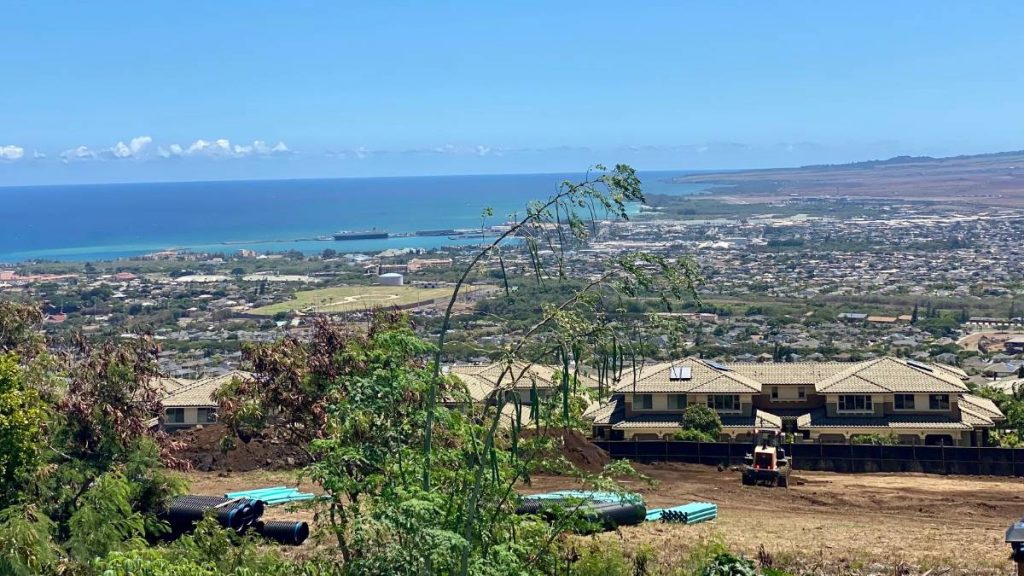Maui County ‘behind eight-ball’ on plan to create 5,000 affordable homes in 5 years

Maui County is far behind its goal of creating 5,000 affordable homes for local people over five years, according to an update this week on the Maui County Comprehensive Affordable Housing Plan.
Since the plan was finalized a couple years ago, 675 homes are being built and another 943 homes are approved for construction. Assuming that 600 rent and homeownership opportunities are secured through other projects outlined in the plan, roughly 3,000 homes are needed in under three years.
In fact, if the county continues on its current path, it will take about 15 years to meet its goal, said Jeff Gilbreath of Hawaiian Community Assets, a nonprofit hired by the county in 2020 to come up with the Maui County Comprehensive Affordable Housing Plan, which was finalized in 2021. The plan was intended to draw a roadmap for creating 5,000 affordable homes for local residents below 120% Area Median Income over five years.
“We’re behind the eight-ball, as you folks probably know,” Gilbreath said.

Council Member Tasha Kama, chairperson of the council’s Housing and Land Use Committee, on Friday said the council and the new administration are getting to work to help facilitate more units.
“One of the most important solutions to this housing crisis is to build new units,” Kama told Maui Now via email. “We are looking to work with the new administration to help speed up the process of getting new housing built, but as we all know, this not an easy or quick process. But if we want our children to have a home, it’s something we must do. The longer we wait, the greater the housing shortfall will be, which may cause even more families to leave.”
Gilbreath during this week’s Maui County Council Housing and Land Use Committee meeting discussed areas of progress — and parts that need work — in the county’s implementation of the Maui County Comprehensive Affordable Housing Plan.
One major area of progress includes the county council’s work to increase the Affordable Housing Fund. In recent times, the council “took some amazing steps” to bolster funding.
“When we started the plan, the Affordable Housing funding was funded at $3 million — it’s now at $58 million . . . that increase happened (by) increasing property taxes on investor properties, vacation rentals so we can take those subsidies and target the real needs of local and Hawaiian families,” Gilbreath said.
However, hurdles abound in creating affordable housing within Maui County.
The first priority to increasing affordable housing that Gilbreath outlined is putting kamaʻāina first by increasing the county Affordable Housing Fund and eligible ways to use the money. For example, leaders can pass legislation to include the money for deferred payment loans, gap financing for rental projects and funding accessory dwelling units.
“Our local and Hawaiian families are having to leave because they can’t afford housing in their home,” Gilbreath’s presentation said.
Currently, the county is sitting on millions in federal funding because the previous administration did not set up a program to distribute the homeowners’ assistance funds. The council recently passed a resolution to urge the administration to move on the federal dollars before they expire. In a letter to the council, the new administration said it is working to get the program launched soon.
The second priority discussed was addressing the market’s current realities. At issue is the county’s zoning code that’s severely outdated and prevents mixed-use, mixed-income communities.
“The zoning code is like 60 years old or more,” Gilbreath said. “We heard from folks across the spectrum that they want to see more mixed-income, more mixed-use neighborhoods that look more like old Maui where you can get your groceries in the same place you’re running your errands, that you can be with other families where the kids can play.”
Gilbreath said that there’s a contractor who has been working on zoning reform for three years and the council could hear a presentation from the contractor.
“That could have a major impact on housing and housing development,” he added.
The administration last year pitched a proposal to change zoning so that residents could occupy commercial buildings in some areas, such as in Queen Ka’ahumanu Center, but the council shut down the proposal in committee.
Also, Gilbreath said the “long, drawn-out process” for affordable housing approvals, all while construction costs and interest rates increase, make it challenging for developers to build and for families to own.
It takes about 24 months for a project to go from start to government approval. In the comprehensive plan, Gilbreath encouraged a by-right development process.
“How can you have a list of design guidelines for a developer or builder to meet, and if they do, move forward with the approval of the project, recognizing that we need public health and safety and we need protection and preservation of cultural and environmental resources,” he said.
Finally, Gilbreath said increasing the county’s capacity to create affordable homes should be priority three.
The county has land to build homes, but only has eight full-time staff dedicated to housing, compared to Hawai’i County, which has 51 staff for housing. Gilbreath encouraged the council to act now by requesting a presentation by the administration on staffing needs for the county Housing and Human Concerns department and what staffing would be needed to create the new Department of Housing.
Also, the plan’s leader said the county-owned land should be used to develop affordable housing and cost-share on infrastructure and other needs with the state Department of Hawaiian Home Lands.









